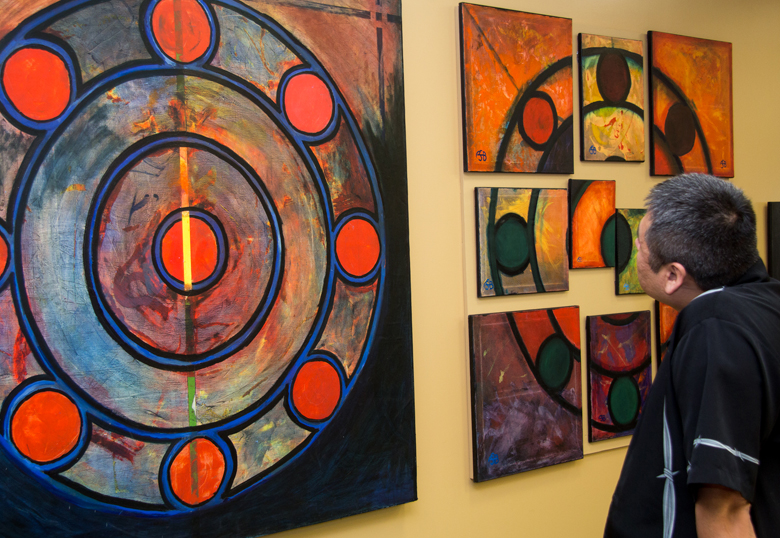The University of Lethbridge Library is embracing the ‘library as place’ concept, recognizing that library users should see themselves mirrored in their surroundings. To that end, the library is celebrating the installation of three pieces of Native American art and the redevelopment of the Blackfoot Digital Library website.

“Our university is located on traditional Blackfoot land and it is important that we respect and honour this heritage,” says Wendy Merkley, associate University librarian. “Our students should feel comfortable and welcomed when they come into the library, and that their culture is valued as an integral part of the University community.”
The pieces of art installed in the library include Medicine Wheel, Ten Grandmothers Quilt and Medicine Bundle.
Medicine Wheel – Artist Grant Spotted Bull
Spotted Bull, of Blackfoot heritage and born and raised on the nearby Blood Reserve, is a fourth-year bachelor of fine arts student at the U of L. His piece is a four-painting series that tells the story of colonialism and its effects on First Nations people.
Ten Grandmothers Quilt
The quilt is a collection of 10 key messages from 10 ceremonial women from southern Alberta and Montana. Their messages are about how to live and raise your children in a positive way. The words they share are not their own, but the words of women from many generations before. Collectively, they say to listen and to care for one another through mistakes, through growth and through change. Just as importantly, they advise to always be self-sufficient and to help one another by sharing.
Medicine Bundle – Artist Gordon Monroe
Monroe is a member of the Blackfeet Tribe in northern Montana. He was born in 1946 in Browning, MT on the Blackfeet Reservation. He started work as a sculptor in 1965, and started teaching art at the Blackfeet Community School in 1972. His works centre on themes of dancers, ceremonies and traditional scenes, creating Medicine Bundle in 1979. It was purchased in 1980 by the University of Lethbridge, through efforts led by professor Alfred Youngman of the Faculty of Fine Arts.
The library is also marking the redevelopment of the Blackfoot Digital Library website. Since 2006, the U of L library has been involved with the Blackfoot Digital Library, helping to gather and digitize artifacts, documents, audiovisual and archival materials. In addition, the library has been a leader in preserving oral histories by digitizing existing interviews and collecting new videos of Elders sharing their knowledge and stories.
“The Blackfoot Digital Library wouldn’t exist without the U of L Library stepping in to give it a permanent home,” says Adrienne Heavy Head, Blackfoot Digital Library liaison. “The digital library is unique in that it is the only indigenous library that focuses on one group of indigenous people and is also created by those people.”



